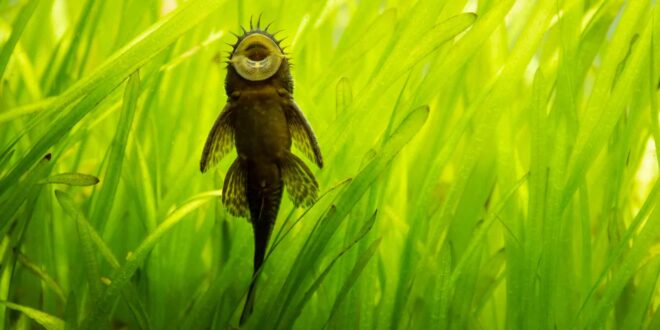The aquatic ecosystem is a dynamic web of interconnections, where various organisms coexist and rely on each other for survival. One such relationship is between fish and algae, which play integral roles in maintaining the delicate balance of underwater life. Fish, as consumers, depend on algae as a primary food source, while algae benefit from the activities of fish through nutrient cycling and habitat creation. This essay explores the relationship between fish and algae, highlighting their interdependence and the significant impact they have on aquatic ecosystems.
Algae: The Foundation of Aquatic Life
Algae, often referred to as the “green plants of the water,” are a diverse group of photosynthetic organisms that exist in various aquatic environments, including freshwater and marine ecosystems. They are responsible for a substantial portion of the Earth’s oxygen production through photosynthesis. Algae encompass a range of organisms, from single-celled microscopic species to complex multicellular forms like seaweed. They come in different colors, including green, red, brown, and even blue-green.
Algae are crucial primary producers in aquatic ecosystems, converting sunlight, carbon dioxide, and nutrients into organic matter through photosynthesis. This process forms the foundation of the food chain and provides sustenance for a variety of organisms, including fish. Algae blooms, although occasionally problematic due to excessive growth, are evidence of the vital role algae play in aquatic habitats.
Fish: Consumers and Algae Regulators
Fish, as consumers within aquatic ecosystems, occupy various trophic levels in the food chain. While some fish are herbivores, relying solely on plants for sustenance, the majority are omnivores or carnivores. This is where the relationship between fish and algae becomes apparent. Herbivorous fish species, such as tilapia, carp, and certain species of catfish, actively feed on algae, making it a significant component of their diet. These fish have specialized adaptations, including specialized teeth or filtering structures, that allow them to consume algae efficiently.
By consuming algae, fish play a crucial role in controlling its growth and preventing excessive blooms. In this way, fish help maintain a healthy balance in the ecosystem, preventing the domination of a single species of algae that could disrupt the diversity and stability of the ecosystem. Moreover, the consumption of algae provides fish with essential nutrients, such as proteins, carbohydrates, and vitamins, enabling their growth and survival.
Nutrient Cycling and Algae
Fish not only rely on algae for sustenance but also contribute to the nutrient cycling within aquatic ecosystems. When fish consume algae, they excrete waste rich in nitrogen and phosphorus compounds. These waste products act as natural fertilizers for algae, enhancing their growth. Algae, in turn, absorb these nutrients, completing a vital nutrient cycle.
This interdependence between fish and algae creates a dynamic equilibrium in which the nutrient requirements of algae are met by the waste products of fish, while fish benefit from the availability of algae as a food source. Consequently, this nutrient cycling supports the overall productivity and biodiversity of the aquatic ecosystem.
Moreso, Ian, a fish expert, while noting the symbiotic relationship between fishes and algae, stated,”Fish and algae have a symbiotic relationship in which algae provide oxygen and food for fish through photosynthesis, while fish provide carbon dioxide and nutrients for algae through their waste. This relationship is essential to the health of aquatic ecosystems and the survival of many fish species. However, excessive algae growth can lead to harmful algal blooms and oxygen depletion, which can have negative impacts on fish populations and their habitats…”
Habitat Creation and Shelter
Beyond the nutritional aspects, fish also influence the growth and survival of algae through their interactions with the physical environment. Fish, especially those that dwell close to the bottom of aquatic systems, stir up sediment and create disturbances as they search for food. This activity promotes the availability of light and nutrients for benthic algae, which thrive in the shallow areas of lakes, rivers, and coastal regions.
Additionally, fish provide shelter and protection for algae. In many cases, algae attach themselves to submerged rocks, vegetation, or even the bodies of fish, using them as anchoring points. This mutualistic relationship allows algae to occupy space and capture sunlight more effectively, while fish benefit from the camouflage provided by algae,
Algae poses no danger to fish when consumed and can serve as a beneficial food source for many fish species. In established aquariums, algae play a crucial role as a filtration system by thriving on ammonia, phosphates, and fish waste products. Aquarists often aim to control the growth of algae in their aquariums as it can be unsightly and adhere to the glass and ornaments. To manage algae growth, they typically introduce algae-eating fish. However, in some cases, these fish may not effectively control the algae.
While algae are safe for fish, not all types of algae are consumed by all fish species. Algae-eating fish tend to prefer green algae varieties.
Can Algae Harm Fish?
Although algae itself is not harmful to fish when consumed, excessive algae growth in an aquarium can be detrimental. Severe algae outbreaks can deplete oxygen levels in the aquarium, and decomposing algae can cause ammonia levels to rise to levels that are toxic to fish and other aquatic organisms.
If an algaecide has been used to eliminate algae in the aquarium, the resulting accumulation of decaying algae can contaminate the water and lead to the death of fish, live plants, and invertebrates. Algae blooms produce algal toxins, which are harmful substances that can be lethal to fish. These toxins are released into the surrounding water as part of the algae’s life cycle, causing harmful algae blooms.
While these blooms are not very common in home aquariums, they can occur in ponds and aquariums with imbalanced water parameters. If your aquarium experiences a harmful algae bloom, it might appear as if the fish are dying from consuming the algae, but in reality, the algae are polluting the water and causing harm to the fish.
Algae Fishes Eat
Fish typically consume green carpeting or hair algae rather than planktonic algae, which causes the water in an aquarium to turn green. These types of algae are considered safer and can be managed in an aquarium or fish pond. Some aquarium owners also introduce algae-eating fish to help regulate the growth of algae.
It is advisable to use algae-eating fish specifically for controlling algae growth in an aquarium, as they may not be effective in resolving severe outbreaks of algae in an already problematic aquarium.
 HammBurg Be informed with latest news, reviews, entertainment, lifestyle tips, and much more.
HammBurg Be informed with latest news, reviews, entertainment, lifestyle tips, and much more.




